This article is a chapter of the pdf document
Khorog Urban culture tour: – Tourism.tj
Chid (Pamiri house) embodies the philosophical оutlook of the Pamir Aryans. We are proud that our home is the kind of book copied from the divine Nature book, which was handed down from our ancestors. Today, this “Book” impresses us with deep philosophical content. It took more than two and a half thousand years since then this “Book” was writen, but it does not become obsolete today. On the contrary, over more time it has got more and more improved. It became one of the finest and memorable architectural creations of the ancient Aryans.
Note:the Pamiri language used, here, is from Khorog, Tajkistan. It is Shughni.
Chid demonstrates comprehensive philosophical approach of our ancestors to nature and to human, both in material and in spiritual concepts. In Aryan religion the Spiritual perfection of human as a direct continuation of his physical development is considered essential. Therefore, spirit and mind are indissoluble and as the base of human entity.
Zoroaster created this religion for the first time in human history, intended to show people his divine nature, and to elevate him to the position of the Creator. God has given mankind a part of his nature – mind, and thus, he raised him above all other creations. This idea of human was borrowed from the Zoroastrians, preserved and developed further by Muslims of Pamir.
The Sun, The Moon, Saturn, Jupiter, Venus, Mars and Uranus as the seven eternals over the land were created by Ahura Mazda. All the other creations of nature, including human, all flesh appeared on earth under their continuous
influence on the land and depend on these principles.
In the maintenance of the Almighty Creator who created the Universe, Man has created a Small house, where he has placed all of the divine. Thus, he underlined the indissoluble link between God and Man, has kept the harmonic correlation of Nature – like the common House
of Mankind and the Chid.
The Aryans believed that the entire Universe God’s House, and for this reason it was forbidden to build a man-made House, in whatever form it was – a church, temple, mosque etc. They believed that the person is not entitled to do so.
Nature, in view of the ancient Aryans consists of three kingdoms – Minerals, Vegetables and Animals. The crown of all these kingdoms is human. Everything in nature consists of a combination of four elements – Earth, Water,
Air and Fire. All these above mentioned principles have been laid down by the ancient Aryans in base of Chid construction, in imitation of God, the Almighty. On the assumption of this, Chid embodies all that God embodied in the Universe, in nature.
Thus, Chid is a kind of manifestation and embodiment of the divine nature of human, which together with the construction of the House started creating other own creations, which did not exist in nature. After all Chid was intended to serve as a shrine to pray and to observe all traditional and religious rites in.
Digits have a particular significance in Zoroastrianism.
- The number one is the unity of God,
- two – permanent feud between right and wrong,
- three – minerals, vegetables and animals,
- four – elements – land, water, air and fire,
- five – Holy persons – Surush, Mehr, Anohito, Zamyod and Ozar and
- seven – Ameshaspentas
are of particular significance in ritual and practice representation. That’s why all these digits are reflected in Chid structure. The Pamiri house is a universe in itself, reflecting the divine essence of Man and the harmony of his relationship with Nature.
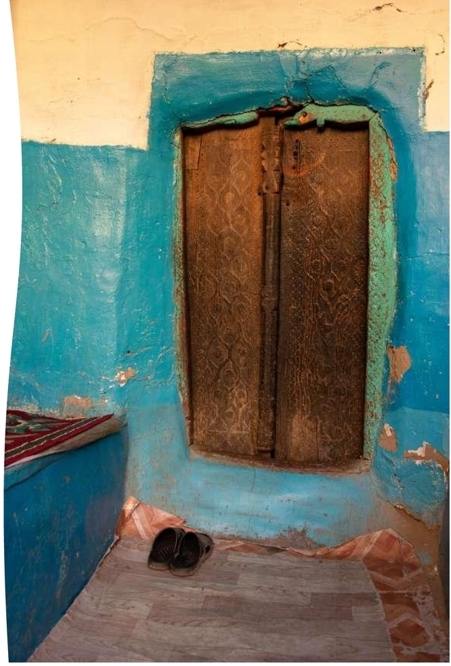
The presentation of Chid construction: confluence of two religious, architectural, religious philosophical and cosmological aspects.
“Deve – Door”
The door of Chid is viewing to the sunrise point, since the Sun is main sacred element of four mentioned above. The old Pamiri house doors were small size and getting in or out of the house was a ritual feature i.e. inclination of the head. It meant worship the sun when one gets out or worships the house when one gets in.
“Haiwonkhona – Barn”
Inside there is no any partition separating Chid into rooms like in European constructions but small partitions about 1 – 1.2m high at the entrance from the right and left sides separating the Chid space from two open rooms that are called “Haiwonkhona – Barn” for housing livestock (in modern Chid these barns are reconstructed into floor space). For ancient Pamiri dwellers it was necessary to preserve their livestock from severe frost in winter and wolves. It is indicative of indissoluble links of human with animal, vegetable and mineral world.
“Obkhin – Drainage”
One of the integral parts of Chid is “Obkhin – Drainage”, an outlet for water where dwellers washed themselves or their clothes in winter. The hole is dug in the center of the house floor.
“Nekhen – Four Stages – platforms”
The raised stage along the sides of the house “Nekh – Stage” (the edge of stage is called “Sandj – lengthwise edged board” where one sits lower his legs on the floor). These stages were surfaced with sand. Nekhen – Stages are embodiment of three kingdoms
- The first stage near the entrance is called “Bar Nekh -Main stage” embodiment of human and animal kingdom. The Calif and distinguished guests are sat on Bar Nekh. This structure mainly serves for religious and traditional rites. In wedding day a bridegroom is shaved and clothed in this stage. The height of stage is about 0,40cm above the floor.
- The second stage next to the Bar Nekh is “Woghz Nekh – Wide stage” embodiment of vegetable kingdom. The new married couple is sat on this stage. The height of stage is a bit lower than Bar Nekh.
- The third and the lower stage of four is “Chalak Nekh -Small stage” embodiment of mineral kingdom. A dead body is washed on this stage and is put on the Bar Nekh to mourn until a grave is dug for him.
- The last construction is “Kitsor Nekh – Stove stage” the higher stage in Pamiri house is the women place since they were obliged for keeping the sacred fire. Kitsor is considered the source of light, warm and the prosperity. Even today fire is used in most rites like lighting candle “Charogravshan” to a deceased person, kindling immortelle “Strakhm” to fragrance the house, cleaning from the evil spirits and jumping over the fire “Alowparak” during the Navruz (New Year) celebration. Before leaving their own house for a long time the dwellers observed a farewell ceremony with kindling immortelle, parting kiss on “Zingak – Stove” and putting a handful of ash in boots for safe journey.

“Sitanen – Pillars”
There are five pillars supporting the house ceiling embodiment of five saints in Zoroastrian Aryan religion and in Islam. After the adoption of Shiism the five pillars began to personify five different in form but identical in essence philosophical comprehensions of the AryanZoroastrian and Islamic world.
The five pillars named after Five Aryan and Muslim religion Holies.
- Kha sitan (Shughni) Suroosh (Aryan)
Muhammad (c) (Muslim) - Vogznekh sitan (Shughni) Mehr (Aryan)
Ali (a) (Muslim) - Kitzor sitan (Shughni) Anahita (Aryan)
Fama (a) (Muslim) - Poygakh sitan (Shughni) Zamyod (Aryan)
Hasan (a) (Muslim) - Barnekh sitan (Shughni) Ozar (Aryan)
Husayn (a) (Muslim)
1. Kha sitan, Surush, Muhammad (c)
It is located in the center of the home and is the main support of the ceiling beam because it accounts for the center of gravity and the main burden of his difficult architectural designs. This pillar personalizes Suroosh – the First creation of Ahura Mazda – his son. In Islam this pillar was called by the name of the last world prophet
Muhammad (c). It is the main pillar of faith, a symbol of eternity, peace and the inviolability of the House. It is a symbol of male power and patronage in the House.
One of the religious rituals of this post is related to the ceremony of laying a newborn baby boy in the cradle. A boy is considered the mainstay and guardian of the House.
2. Wogznekh sitan, Mehr, Ali (a)
In the Aryan religion this pillar represents the Mehr – one of the first and main Ameshaspands. He was the first creation of Ahura-Mazda along with Surush. Mehr is the angel of Light and guardian of the obligation. In Islam Ali (a) Represents the Asos – Base of confession.
Ali is the second figure in Shia after the prophet and embodies Loyalty and Devotion. In Aryan and Muslim religion this pillar is associated with a primary rite of ethnographic character – Wedding. When the groom brings the bride to his house they sit under this pillar to strengthen their love and happiness.
3. Kitzor sitan, Anahita, Faitma (a)
This pillar is symbolizing Anahita, guardian of waters, the spirit of sustenance and nurturing. It’s the place of honor, solely for the women. During the wedding ceremony women are dressed at this pillar since Anahita personifies beauty and piety she is also the guardian of sacred fire and the stove. Some fire rituals are held at this place. As for Fatima (a) the daughter of Prophet Muhammad (c) and the wife of Ali (a) she is revered as a godly woman the Mother of all Muslim women.
4. Poygakh sitan, Zamyod, Hasan (a) and Barnekh sitan, Ozar, Husayn (a)
The fourth, Poygakh – sitan, and fith, Barnekh sitan, pillars are joined to show the closeness of the relationship
between Zamyod and Ozar for Aryan and Hassan (a) and Hussein (a). Zamyod is the guardian of earth and the spirit of being grounded, practical and productive; the Muslim name for this pillar is Hassan (a), the eldest son of Ali, who left no offspring. May be for this reason, this post is not related to any rituals.
5.Barnekh sitan,
the last pillar personifies Zoroastrian Ozar – the son of Ahura Mazda, guardian of fire, the spirit
of truthfulness, goodness and the light of wisdom. He is considered the main successor of the Aryan Zoroastrian religion. Most of religious practices of Zoroastrian and Muslim are occurred at that pillar. For example: Charograwshan a ritual of lighting candle in mourning ceremony to a deceased person. Hussein (a), the younger son of Ali was a direct descendant of the House of the Prophet. The pillars are joined with “Buchkagij – Crossbar” showing the closeness of the relationship between two Holies. The crossbar is carved with Zoroastrian era symbols including depiction of the sun in centre and the Swastika (cross) “Shamshod”.

“Wusen – 2 Beams (long)”
There are two long bearing beams the main support of roof. The first long beam is lean on two pillars Suroosh – Muhammad (c) and Mehr – Ali (a) represenng the “Mainyu” – the Spiritual World in the Aryan religion, and the Universal Mind (Akli Kull) in Ismailism. The second one is lean on three pillars Anahita – Fatima, Zamyod – Hasan (a) and Ozar-Husayn (a) is representing the “Geti” – Material world in the Aryan religion, and the Universal Soul (Nafsi Kull) in Ismailism.
These two long beams support 44 intermediary beams and the skylight complex.
“Sipokhchen –13 Beams (short)”
There are thirteen beams six of them are situated over the Kitzor – Stove place. They are embodiment of six conceptions in Aryan religion; Vakhumana – Good Thoughts, Asha – Order, Justice, Khshatra Vayra – Power, Spenta Armaity – Resignation, Khaurvatat – Health, Ameretat – Eternity and six world Prophets; Adam, Noah, Abraham, Moses, Jesus and Muhammad.
The other seven beams are situated over the Bar Nekh – Main stage embodiment of seven heavenly bodies are symbolizing seven planets The Sun, The Moon, Saturn, Jupiter, Venus, Mars and Uranus which were converted into seven Imams in Shia: Ali (a), Hasan (a), Hussein (a),
Zainullobiddin (a), Muhammad Bokir (a), Jafare Sodik (a) and Ismail (a).
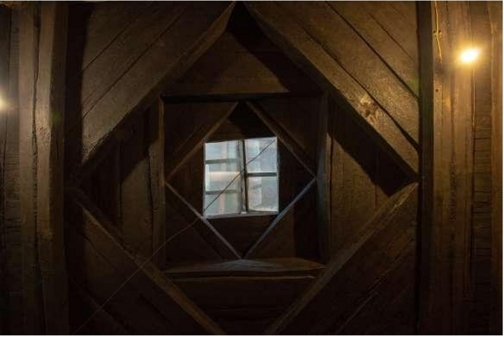
“31 Beams along the edges (short)”
18 beams are located along the edges over the entrance and 17 of them over the Woghz Nekh – Wide stage. There is no reliable source about these 31 beams in Aryan conception. In Islam they mean 18 executers of divine services and 17 levels of God’s perceptions.
“Chorkhona – The Skylight”
The last construction of the house is built with four concentric square boxes – type layers representing in Aryan four elements; earth, water, air and fire, the later is first touched by sun’s rays, and in Shia four conceptions; Shariat – legality, Tarikat – Practice, Makhrifat – Intelect and Hakikat – Truth. This interaction hierarchy shows the consistency of philosophical conception. By the help of skylight, dwellers determined spring approach to start field works – cultivate lands and to celebrate New Year – Navruz.

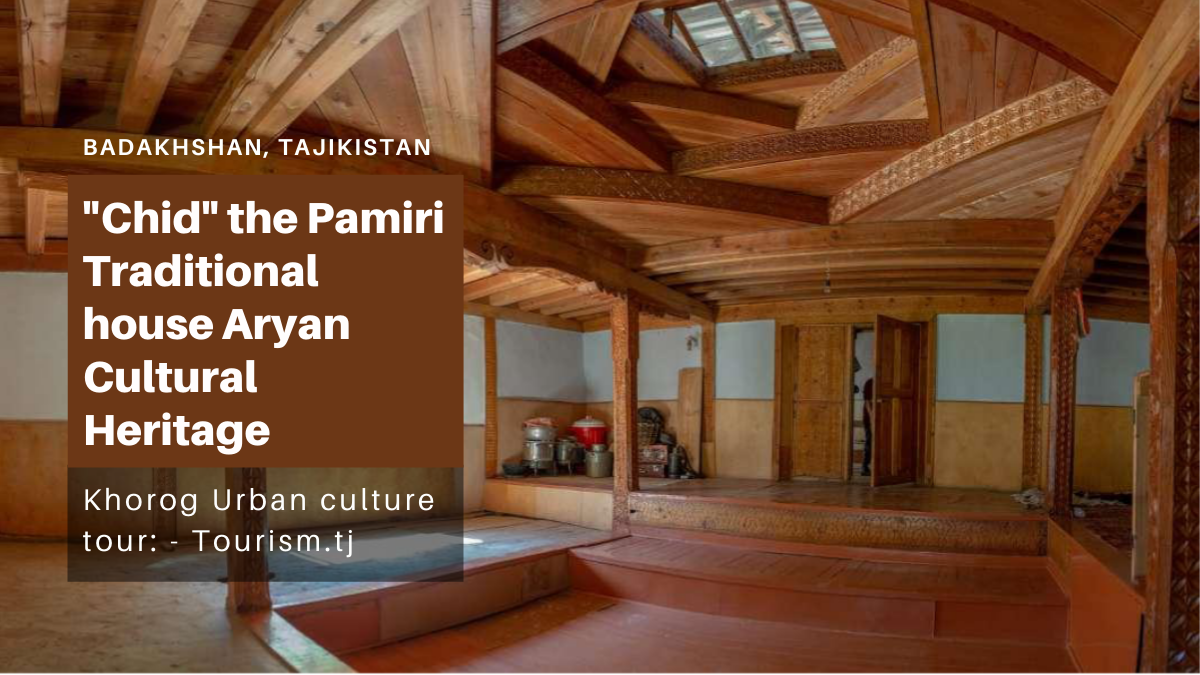
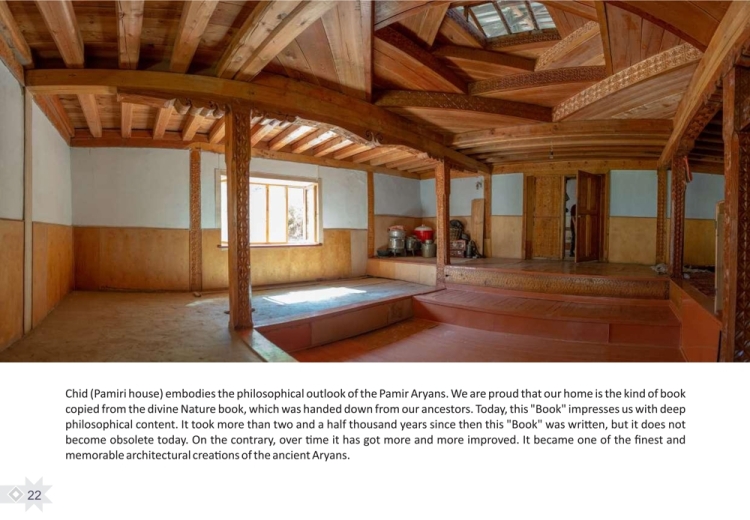

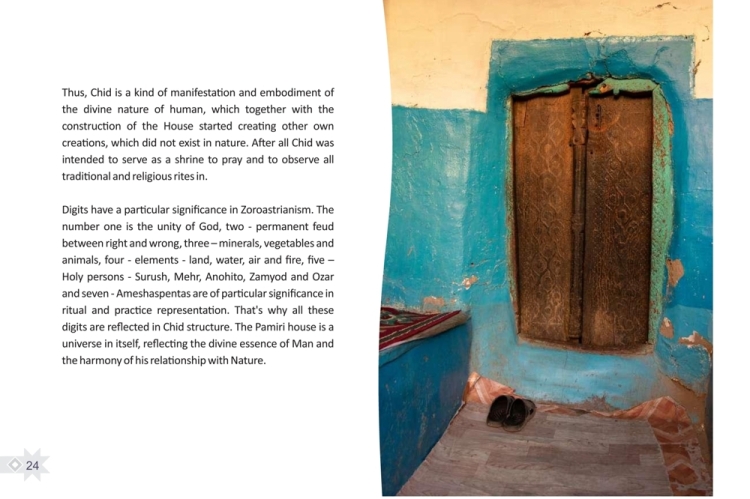
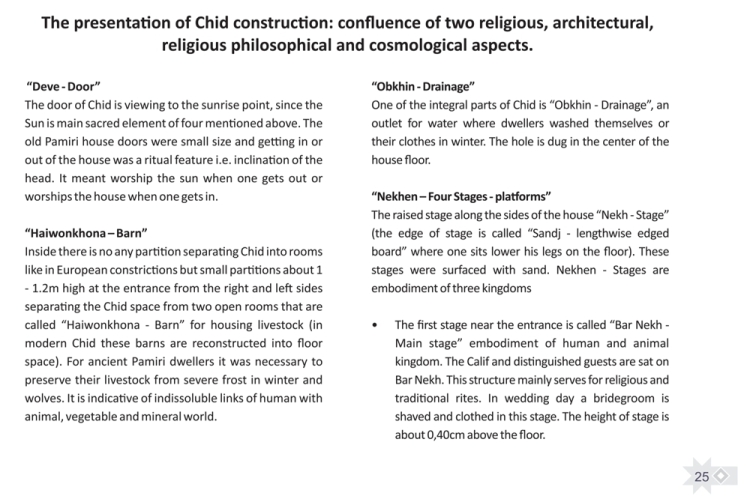


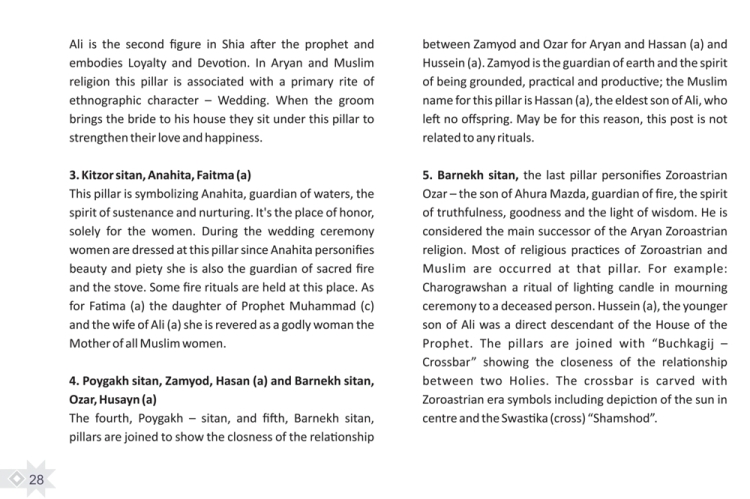



2 thoughts on ““Chid” the Pamiri Traditional house Aryan Cultural Heritage”